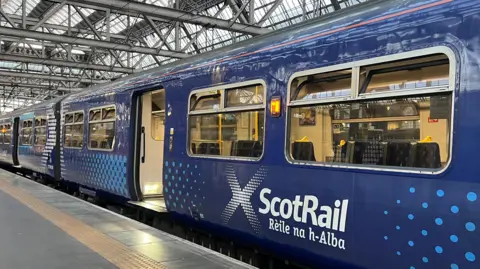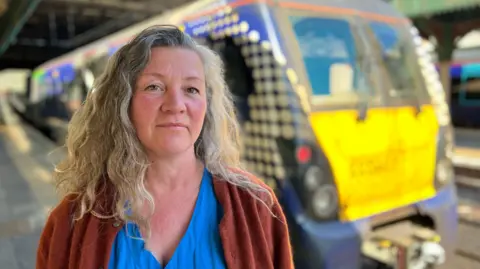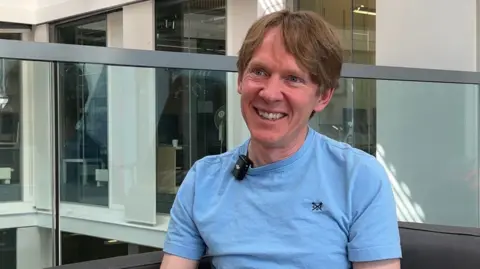'Give it time' - ScotRail defends AI announcer Iona
 ReadSpeaker
ReadSpeakerPassengers on ScotRail trains have been noticing a new voice announcing the station arrivals and some have not been pleased.
The new announcer, called Iona, has recently taken over on some routes. But unlike her predecessors, she is not real.
Previously announcements were pre-recorded by a Scottish voice artist, but Iona is a synthetic voice which uses an AI model to deliver typed messages in a "Scottish accent".
ScotRail urged passengers to "give it time and it may grow on you".
It said tricky place names such as Milngavie and Achnasheen are inputted phonetically as "Mill-guy" and "Akna-sheen" to help the software avoid embarrassing mistakes.
Although the technology has not yet been fully implemented, some passengers have already voiced their unhappiness with the change.
One passenger told BBC Scotland: "It was weird. I could tell it was AI because it sounded so robotic."
Another posted on X that the voice sounds unsure of what it is saying and questions everything.
One passenger described it as an "AI lassie" that was "so horrible and unnatural".
In response, ScotRail said: "Sorry you're not a fan. I love the new voice but appreciate it may not to be everyone's liking. Give it time and it may grow on you."

The new announcer was developed by global technology company, ReadSpeaker, which has over 50 language iterations of its text-to-speech software.
The team also AI-generated an image that matched the name Iona to feature on their website.
The end result is a red-haired woman wearing a woolly orange scarf and green jacket stood in the middle of a Scottish glen.
Allow X content?
Allow X content?
Allow X content?
The technology means drivers or operators can type customised announcements on a computer and Iona then reads them out.
The first service featuring Iona was trialled quietly in July 2024, but a recent extension of the technology has led to more passengers noticing the change.
Only certain services from Glasgow's train stations currently feature the technology.
Among the first passengers to notice the change are on the Glasgow Central services to Ayr, Largs, Ardorssan, Barrhead and Paisley.
From Glasgow Queen Street, Iona has been heard on trains bound for Inverness, Dundee and Aberdeen.
This system is only used on ScotRail trains and will not include stations.

'Replacing real humans'
Rachel Nicholson, a voice coach and former actress based in Edinburgh, said replacing human announcers with an AI voices affects both jobs and identity.
"It's really sad that they want to replace real humans and put them out of work," she said.
"Just because it saves money doesn't mean it's the right thing to do."
Ms Nicholson has spent more than 15 years working in the creative industries and said the topic of AI voices is often a tricky one in her world.
"It's a bit taboo, honestly," she said.
"This is a real voice, a human voice, being replaced that was doing a perfectly good job."

Ms Nicholson said the new ScotRail voice is clear and easy to understand but questioned whether clarity was enough.
"They're clearly struggling with some of our more unique names like the 'ch' in 'loch'.
"If someone's travelling around Scotland, don't we want them to hear those names said the way we actually say them?"
For her, this goes beyond speech - it's about preserving a sense of place.
"We should be proud of our languages and place names. What this might be doing is diluting how those names are remembered, and I think that's a real shame."
Ms Nicholson, who is also an accent coach, is often asked to teach a "general Scottish" accent - something she says she finds a bit odd.
"I don't know any Scot who'd describe themselves as 'general'.
"It feels like they're going for something neutral but it ends up feeling like a missed opportunity. Why not regional?
"I don't think I could pin Iona's accent on a map."
Lifelike voices
Prof Peter Bell, a speech technology expert at the University of Edinburgh, said the growing power of artificial intelligence has made it significantly easier - and cheaper - to create synthetic voices.
"We can now give a system just a couple of sentences of someone's voice and it can immediately start to speak like them," he said.

The technology is now capable of producing speech that sounds convincingly human, with companies able to generate voices at a fraction of the cost of earlier systems, he said.
But despite the progress, some synthetic voices don't always resonate with listeners.
"People care a lot about the identity of an accent or a speaker, so they often treat it differently from other types of AI, as they don't want to be fooled in that way," he said.
"Even when a voice is very good, there's this uncanny feeling - is it a real voice, or is it not?"
Prof Bell believes cost savings are a major motivator for companies switching to use new technology instead of previously hiring "expensive" voice talent.

'Local' voices onboard trains
ReadSpeaker said ScotRail first made inquries three years ago about adopting their technology.
"We use AI just to train the voice, but at the base it is a real human speaker. That's important to us," said Roy Lindemann, co-founder of ReadSpeaker.
Much like early adoptions of text-to-speech, he said they worked with voice talent to create their synthetic Scottish character.
The firm says in future the technology could allow for "regional" and "local" voices across any network.
"It is definitely a path forward," Mr Lindemann said.
Phil Campbell, ScotRail's customer operations director, said the new system would allow "flexibility" and "consistency" across its network.
He said: "ScotRail has always used automated announcements in relation to customer information.
"It doesn't replace human interaction through either pre-recorded audio or staff on trains."
